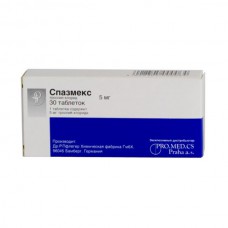Expiration date: 05/2025
The composition and form of issue:
Tablets. 1 tablet contains:
tropia chloride 5 mg
excipients: lactose monohydrate sodium starch of glycolate corn starch, stearic acid povidone (K25) silicon dioxide colloidal
in a contour acheikova packing 10 PCs per cartons 3 or 5 packs.
Tablets, film-coated. 1 tablet contains:
tropia chloride 15 or 30 mg
excipients: lactose monohydrate microcrystalline sodium starch of glycolate corn starch, stearic acid povidone (K25) silicon dioxide colloidal
shell — hypromellose, stearic acid titanium dioxide MKC
in a contour acheikova packing 10 PCs per cartons 3 or 5 packs (15 mg) or 3 packs (30 mg).
Description pharmaceutical form:
Tablets 5 mg: round, odourless, biconvex tablet white, or almost white.
The tablets, coated tablets, 15 mg: round, odourless, biconvex coated tablets white or almost white scored one side.
The tablets, coated tablets, 30 mg: round, odorless, convex-concave coated tablets white or almost color with a deep break-line on the concave side.
On a break (for tablets 15 and 30 mg) are visible - and the film cover both layers of white, or almost white.
Feature:
Quaternary ammonium base group anticholinergics.
Pharmacokinetics:
Once inside C max in plasma is reached after 4-6 h T1/2 — 5-18 h, not accumulates. Linking blood plasma proteins is 50-80%. Trope the concentration of chloride in single dose at a dose of 20 to 60 mg proportional to the dose. Excreted by the kidneys, the most part unchanged, around 10% — in the form of serialconsole, metabolite, formed by hydrolysis of its ester linkages.
Description pharmacological action:
Is a competitive antagonist of acetylcholine receptors on the postsynaptic membranes of smooth muscles. Has a high affinity for M1-, m2 - and m3-receptors.
Reduces increased activity of the bladder detrusor. Papaverinopodobnoe having a myotropic effect. Does not have Central effects.
Indications:
- urinary incontinence and imperative urination with idiopathic and neurogenic detrusor hyperactivity (multiple sclerosis, spinal trauma, congenital and acquired diseases of the spinal cord, strokes, Parkinson's disease, etc.)
- the detrusor-sphincter dyssynergia on the background of intermittent catheterization
- in the treatment of cystitis, accompanied by a peremptory symptoms
- pollakiuria and nocturia, nocturnal and daytime enuresis
- mixed forms of urinary incontinence.
Contraindications:
- hypersensitivity to the drug
- urinary retention
- narrow-angle glaucoma
- tachyarrhythmia
- myasthenia gravis
- the age of 14 years (adequate and strictly controlled studies of the use of Tropea chloride in children have not been conducted).
With caution:
- diseases of the cardiovascular system, which increased heart rate may be undesirable: tachycardia, congestive heart failure, coronary artery disease
- thyrotoxicosis
- increased body temperature
- reflux esophagitis, hiatal hernia of the diaphragm, combined with reflux-esophagitis
- diseases of the gastrointestinal tract, accompanied by obstructive conditions: achalasia and pyloric stenosis
- intestinal atony in elderly patients or debilitated patients
- paralytic ileus
- diseases with increased intraocular pressure, angle-closure and open angle glaucoma
- chronic inflammatory bowel disease (Crohn's disease, ulcerative colitis)
- dry mouth
- renal failure
- chronic lung disease, especially in immunocompromised patients
- vegetative (autonomic) neuropathy
- toxemia of pregnancy
- Cerebral palsy
- down syndrome.
Application of pregnancy and breast-feeding:
The use of Tropea chloride during pregnancy and lactation is possible only in case when expected benefit for mother exceeds the potential risk to the fetus and child (adequate, well-controlled studies of the use of Tropea chloride in pregnant women and in lactation period were not carried out).
Side effects:
Frequency of occurrence (number of cases : number of cases): often more than 1:100 or sometimes 1:100-1000, rarely less than 1:1000.
Of the cardiovascular system: rarely- tachycardia.
By the blood: often — dry mouth, dyspepsia, constipation, nausea.
CNS: sometimes — paresis of accommodation.
From the urinary system: sometimes — a violation of the emptying of the bladder.
Allergic reactions: sometimes — skin rash.
Drug interactions:
Enhances the effect of amantadine, tricyclic antidepressants, quinidine, antihistamines drugs disopyramide, beta-agonists.
Method of application and dose:
Inside, before meals, with liquid, squeezed enough water.
Adults and children from 14 years the drug is prescribed individually depending on the clinical picture and severity of the disease, and 10 mg 3 times a day (30 mg/day) or 15 mg 2-3 times per day (30-45 mg/day). At a daily dose of 45 mg also acceptable to take 30 mg morning and 15 mg in the evening. In neurogenic detrusor hyperactivity administered 15-20 mg 2 times a day morning and evening (30-40 mg/day). The average duration of treatment is 2-3 months.
After the disappearance of symptoms is recommended anti-relapse treatment within 2-4 weeks. If you need a longer therapy continued treatment are reviewed by the doctor every 3-6 months.
In patients with renal insufficiency (Cl creatinine 10-30 ml/min/1,73m2) daily dose should not exceed 20 mg.
Overdose:
Symptoms: blurred vision, tachycardia, dry mouth, flushing of the skin.
Treatment: gastric lavage and the appointment of adsorbents (activated carbon, etc.), local administration of pilocarpine in patients with glaucoma, catheterization if urinary retention. In severe cases, the appointment of cholinomimetics (e.g. neostigmin). With little effect, severe tachycardia and/or circulatory instability — introduction beta-blocker (e.g. 1 mg propranolol/under control of ECG and AD).
Special instructions:
Before treatment it is necessary to exclude organic causes of pollakiuria and incontinence of urine, such as heart or renal failure, polydipsia, tumours of the urinary tract.
At infringement of function of the urethral sphincter or detrusor must be full release of the bladder by catheterization.
During treatment should refrain from driving vehicles and activities potentially hazardous activities, require high concentration and psychomotor speed reactions.
Not detected interactions tropia chloride with enzymes of cytochrome P450 involved in the breakdown of drugs in the process of metabolism (P450 1A2, 2A6, 3?9, 2C19, 2D6, 2E1, 3A4). So it is not expected interactions with other medications affecting the cytochrome system.
Review:
Exclusive distributor — PRO.MED.CS Praha a.s. (Czech Republic).




